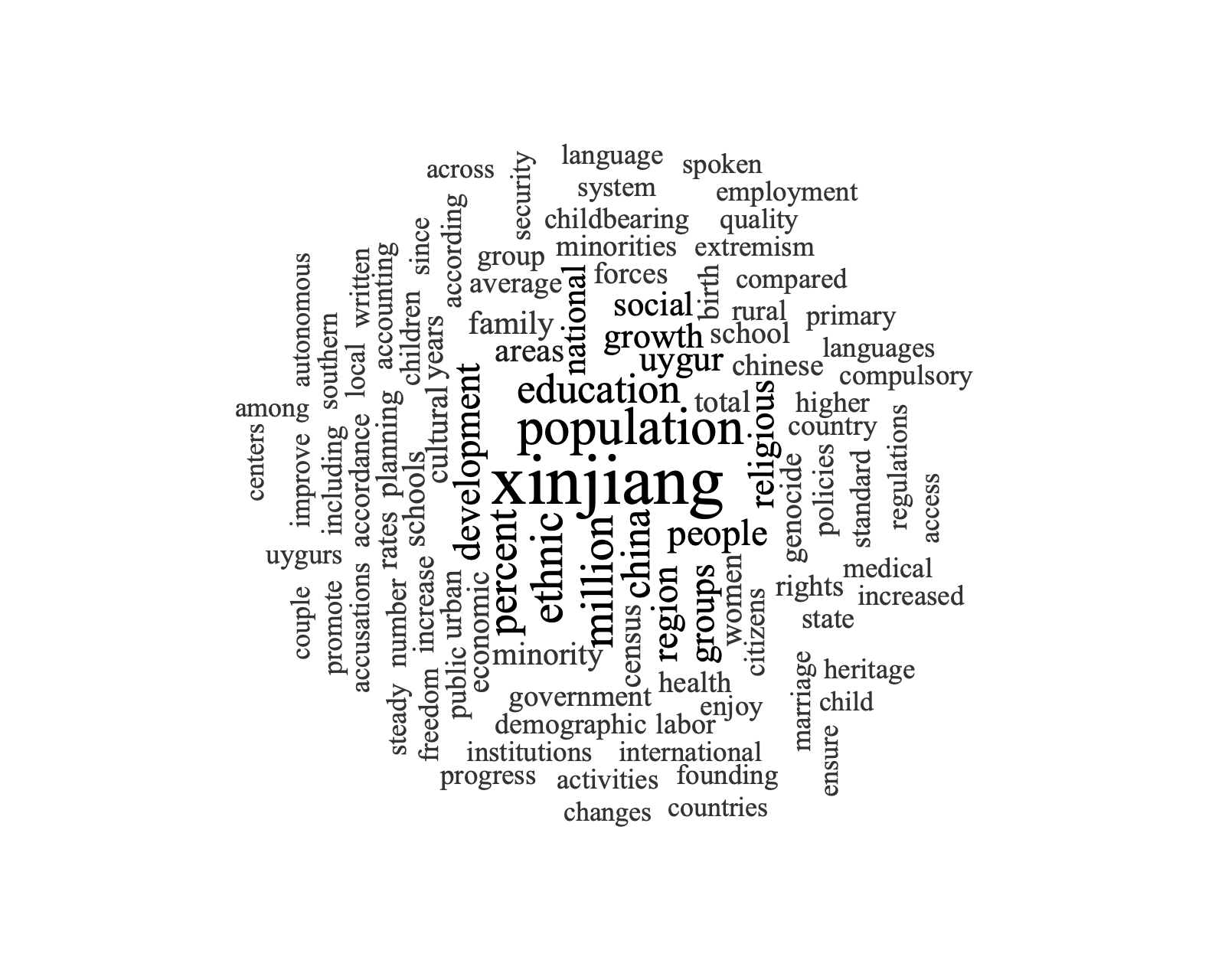Original document link: Click Here
Overview
This official Chinese government white paper, “Xinjiang Population Dynamics and Data”, highlights key historical and present-day demographic trends from the perspective of the state. The paper is divided into six main sections including: Population Growth in Xinjiang, Latest Demographics of Xinjiang, Demographic Changes in the Uyghur Population, Factors Contributing to Xinjiang’s Demographic Development, Xinjiang’s Population Prospects, and Falsehoods Fabricated by Anti-China Forces.
Population Growth in Xinjiang opens by maintaining that prior to the founding of the People’s Republic of China (PRC), “people of all ethnic origins in the region (Xinjiang) led an extremely hard life with little security”. This discusses how the population grew very slowly despite the vast territory, in part due to the war within the region. The section notes that when the PRC gained control of the territory, Xinjiang underwent a period of rapid population growth for the next several decades. While the population growth has slowed down from 2000-2020, it is still higher than the national average and has seen continuous growth in the ethnic minority population.
Latest Demographics of Xinjiang covers an array of official statistics including gender composition, age breakdown, education level, life expectancy, etc. As of 2020, Xinjiang is about 52% male and 48% female with most of the population falling between the ages of 15-59 (about 66% of the population). The average years of schooling for people aged 15+ rose in the past ten years by about a year as well as the average life expectancy. Lastly, it notes that most of the population lives in urban areas in the northern parts of Xinjiang, however, a large amount of the population lives in more rural areas in the southern parts.
Demographic Changes in the Uyghur Population focuses on the growth of the Uyghur population in Xinjiang for the past seven decades. It shows how the Uyghur population has continually grown every year since 1953. The section explains that educational attainment has steadily increased for Uyghur populations, as well. It notes that about 84% of Uyghurs in Xinjiang live in four southern parts including Kashgar Prefecture, Hotan Prefecture, Aksu Prefecture, and Kizilsu Kirgiz Autonomous Prefecture.
Factors Contributing to Xinjiang’s Demographic Development notes that Xinjiang has experienced the processes of industrialization, urbanization, and modernization alongside three growth periods with the current period reflecting low birth rates, low death rates, and low growth rates. This section argues that this current growth period is a result of economic and social development, the evolution of policies and regulations, and changes in views on marriage and childbearing. In economic and social development, the paper reports that GDP and per capita regional GDP have continuously grown since 1952, alongside educational attainment in the region and infant mortality rate. Regarding the policies and regulations, the paper suggests that “preferential policies were implemented for ethnic minority groups” resulting in a steady growth rate for the population. As of 2017 new universal family planning policies were set into place for all ethnic groups allowing for “two children per couple for urban residents and three per couple for rural residents”. Lastly, changes in marriage and childbearing maintains that those living in the southern region of Xinjiang lived “under the prolonged, persuasive, and toxic influence of religious extremism” resulting in early marriage and childbearing. However, the report continues: when “law-based deradicalization was implemented in Xinjiang… views on marriage, childbearing and family have changed accordingly”. Now late marriage and childbearing “have penetrated deep into the hearts of local people ” as per the government’s policy change.
Xinjiang’s Population Prospects suggests that ethnic minority groups in Xinjiang have the potential to grow given that the population is young with a large population of women who are of childbearing age. With the new universal family planning policy and increased quality of Xinjiang’s education system, there is a strong focus on boosting birth rates in the region. This will be supported by “encourag[ing] women to throw off the shackles of religious extremism and participate in social and economic activities so that they can realize their full potential…” Simultaneously, the government is promoting people-centered urbanization by encouraging ethnic minority groups to move into urban areas outside of their “concentrated communities”. The section closes by stating that because of the favorable location of Xinjiang and its abundant resources, investors will be attracted to the Silk Road Economic Belt and the “implementation of the national strategy to develop western China”.
Falsehoods Fabricated by Anti-China Forces focuses on accusations against China of forced labor, mandatory sterilizations, parent-child separation, cultural genocide, and religious persecution. Each is followed by official rebuttals and claims that the government is protecting the rights of Uyghurs and all other ethnic groups in Xinjiang.
| 15 most common words: | |
|---|---|
| Word | Count |
| xinjiang | 107 |
| population | 64 |
| ethnic | 49 |
| million | 48 |
| percent | 41 |
| education | 40 |
| china | 37 |
| development | 31 |
| people | 29 |
| region | 29 |
| groups | 27 |
| religious | 26 |
| uygur | 24 |
| growth | 23 |
| national | 22 |
Word cloud: (Minimum 5 letters)
